Management Accounting Concepts and Practices
VerifiedAdded on 2020/02/03
|18
|5574
|119
Essay
AI Summary
This assignment delves into the core principles of management accounting, examining concepts such as marginal cost, budgetary control, and their significance in organizational decision-making. Students are required to demonstrate understanding of these concepts through referencing relevant academic sources and online materials.
Contribute Materials
Your contribution can guide someone’s learning journey. Share your
documents today.
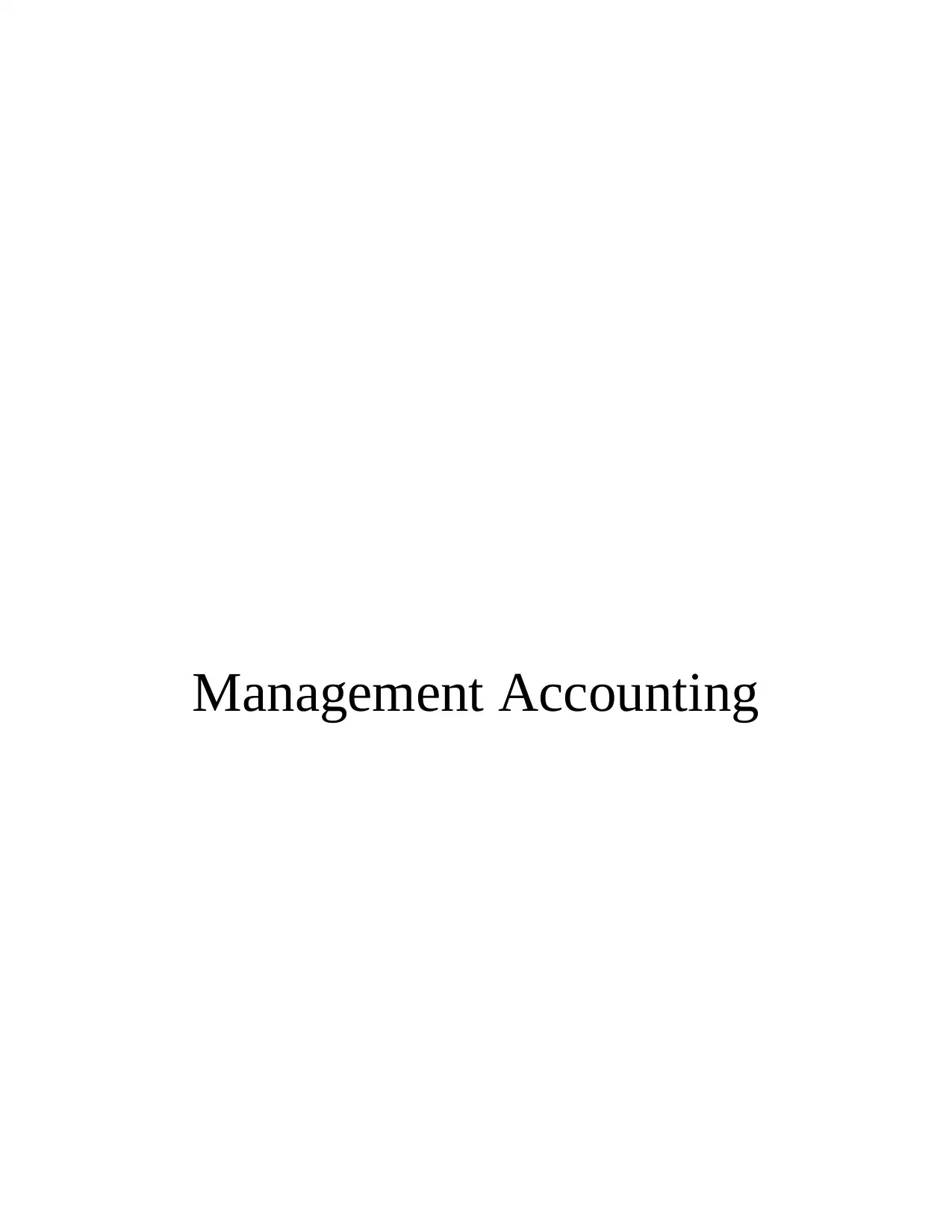
Management Accounting
Secure Best Marks with AI Grader
Need help grading? Try our AI Grader for instant feedback on your assignments.
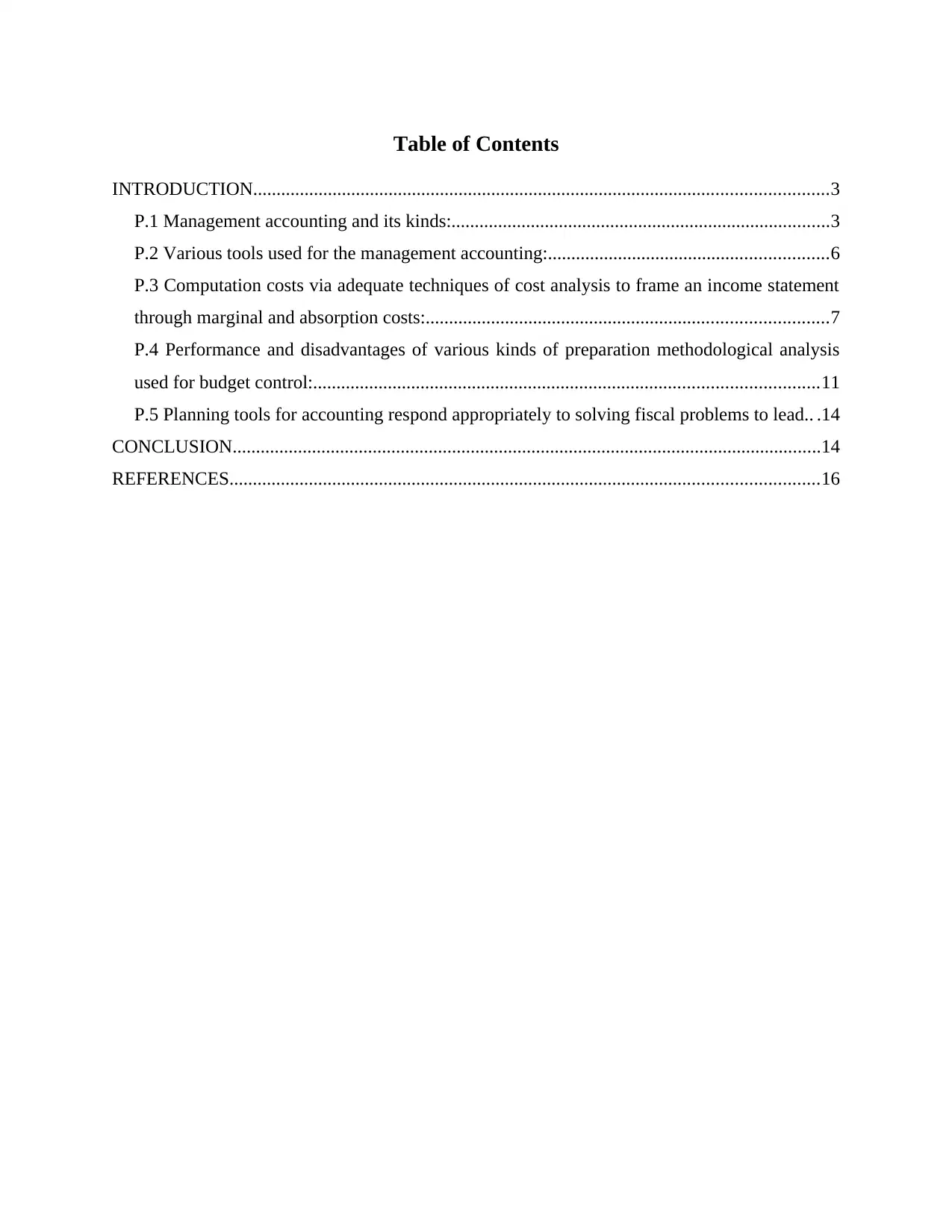
Table of Contents
INTRODUCTION...........................................................................................................................3
P.1 Management accounting and its kinds:.................................................................................3
P.2 Various tools used for the management accounting:............................................................6
P.3 Computation costs via adequate techniques of cost analysis to frame an income statement
through marginal and absorption costs:......................................................................................7
P.4 Performance and disadvantages of various kinds of preparation methodological analysis
used for budget control:............................................................................................................11
P.5 Planning tools for accounting respond appropriately to solving fiscal problems to lead.. .14
CONCLUSION..............................................................................................................................14
REFERENCES..............................................................................................................................16
INTRODUCTION...........................................................................................................................3
P.1 Management accounting and its kinds:.................................................................................3
P.2 Various tools used for the management accounting:............................................................6
P.3 Computation costs via adequate techniques of cost analysis to frame an income statement
through marginal and absorption costs:......................................................................................7
P.4 Performance and disadvantages of various kinds of preparation methodological analysis
used for budget control:............................................................................................................11
P.5 Planning tools for accounting respond appropriately to solving fiscal problems to lead.. .14
CONCLUSION..............................................................................................................................14
REFERENCES..............................................................................................................................16
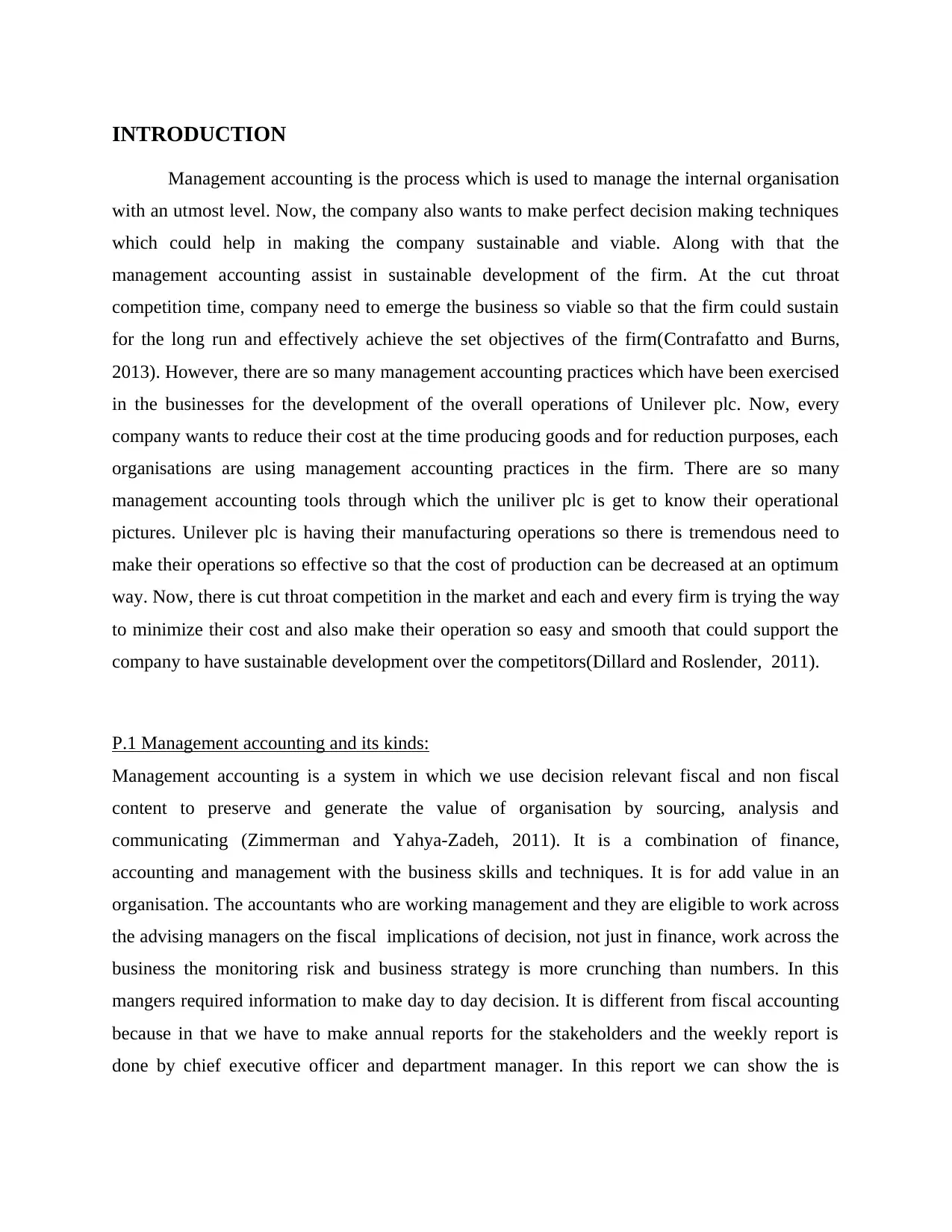
INTRODUCTION
Management accounting is the process which is used to manage the internal organisation
with an utmost level. Now, the company also wants to make perfect decision making techniques
which could help in making the company sustainable and viable. Along with that the
management accounting assist in sustainable development of the firm. At the cut throat
competition time, company need to emerge the business so viable so that the firm could sustain
for the long run and effectively achieve the set objectives of the firm(Contrafatto and Burns,
2013). However, there are so many management accounting practices which have been exercised
in the businesses for the development of the overall operations of Unilever plc. Now, every
company wants to reduce their cost at the time producing goods and for reduction purposes, each
organisations are using management accounting practices in the firm. There are so many
management accounting tools through which the uniliver plc is get to know their operational
pictures. Unilever plc is having their manufacturing operations so there is tremendous need to
make their operations so effective so that the cost of production can be decreased at an optimum
way. Now, there is cut throat competition in the market and each and every firm is trying the way
to minimize their cost and also make their operation so easy and smooth that could support the
company to have sustainable development over the competitors(Dillard and Roslender, 2011).
P.1 Management accounting and its kinds:
Management accounting is a system in which we use decision relevant fiscal and non fiscal
content to preserve and generate the value of organisation by sourcing, analysis and
communicating (Zimmerman and Yahya-Zadeh, 2011). It is a combination of finance,
accounting and management with the business skills and techniques. It is for add value in an
organisation. The accountants who are working management and they are eligible to work across
the advising managers on the fiscal implications of decision, not just in finance, work across the
business the monitoring risk and business strategy is more crunching than numbers. In this
mangers required information to make day to day decision. It is different from fiscal accounting
because in that we have to make annual reports for the stakeholders and the weekly report is
done by chief executive officer and department manager. In this report we can show the is
Management accounting is the process which is used to manage the internal organisation
with an utmost level. Now, the company also wants to make perfect decision making techniques
which could help in making the company sustainable and viable. Along with that the
management accounting assist in sustainable development of the firm. At the cut throat
competition time, company need to emerge the business so viable so that the firm could sustain
for the long run and effectively achieve the set objectives of the firm(Contrafatto and Burns,
2013). However, there are so many management accounting practices which have been exercised
in the businesses for the development of the overall operations of Unilever plc. Now, every
company wants to reduce their cost at the time producing goods and for reduction purposes, each
organisations are using management accounting practices in the firm. There are so many
management accounting tools through which the uniliver plc is get to know their operational
pictures. Unilever plc is having their manufacturing operations so there is tremendous need to
make their operations so effective so that the cost of production can be decreased at an optimum
way. Now, there is cut throat competition in the market and each and every firm is trying the way
to minimize their cost and also make their operation so easy and smooth that could support the
company to have sustainable development over the competitors(Dillard and Roslender, 2011).
P.1 Management accounting and its kinds:
Management accounting is a system in which we use decision relevant fiscal and non fiscal
content to preserve and generate the value of organisation by sourcing, analysis and
communicating (Zimmerman and Yahya-Zadeh, 2011). It is a combination of finance,
accounting and management with the business skills and techniques. It is for add value in an
organisation. The accountants who are working management and they are eligible to work across
the advising managers on the fiscal implications of decision, not just in finance, work across the
business the monitoring risk and business strategy is more crunching than numbers. In this
mangers required information to make day to day decision. It is different from fiscal accounting
because in that we have to make annual reports for the stakeholders and the weekly report is
done by chief executive officer and department manager. In this report we can show the is

available in cash and the revenue is generated, raw material, discrepancy analysis, outstanding
debts etc.
Management accounting systems vary from their uses. Each system is designed to give
Management varying information based on the needs of Management to aide in the decision
making.
The most basic types of Management Accounting Systems are:
Cost Accounting System
Inventory Management System
Job-Costing System
Price-Optimization System
Lean accounting
Lean accounting: it is very crucial fro the development and viability of the firm. As, this is
completely new from the traditional accounting system. As, this framework is mainly focused
on the cost reduction of the production process. And also help the administration of the Unilever
plc to make the methodology for the delivering the better profits with the minimum cost. As this
is the latest accounting technique. Lean accounting helps the organization to change the
accounting, administration methodology so that powerful production procedure should be
possible. Lean accounting system upgraded the cost as standard costing execute the labour and
overheads cost. There is just a single negative effect of lean accounting which linked the
standard costing in the manufacturing procedure.
In management accounting there are two types of users primary users and secondary
users. Primary users are internal users and secondary users are external users.
Management,employees and owners are the part of internal users. Management analyse the
performance of the Unilever and take measures to improve company results. Employees are the
part of company who are assigned to earn the profit and show in the books of accounting
(Baldvinsdottir Mitchell and Nørreklit, 2010). Owners is for analyse profitability of their
investment funds. These all are some primary users. Secondary users of accounting information
are creditors, tax authorities, investors, regulatory authorities and customers. Customers are the
part of accounting because if customer will purchase the product then it will be shown in
accounting. Tax authority shows the credibility of tax return on behalf of company.
debts etc.
Management accounting systems vary from their uses. Each system is designed to give
Management varying information based on the needs of Management to aide in the decision
making.
The most basic types of Management Accounting Systems are:
Cost Accounting System
Inventory Management System
Job-Costing System
Price-Optimization System
Lean accounting
Lean accounting: it is very crucial fro the development and viability of the firm. As, this is
completely new from the traditional accounting system. As, this framework is mainly focused
on the cost reduction of the production process. And also help the administration of the Unilever
plc to make the methodology for the delivering the better profits with the minimum cost. As this
is the latest accounting technique. Lean accounting helps the organization to change the
accounting, administration methodology so that powerful production procedure should be
possible. Lean accounting system upgraded the cost as standard costing execute the labour and
overheads cost. There is just a single negative effect of lean accounting which linked the
standard costing in the manufacturing procedure.
In management accounting there are two types of users primary users and secondary
users. Primary users are internal users and secondary users are external users.
Management,employees and owners are the part of internal users. Management analyse the
performance of the Unilever and take measures to improve company results. Employees are the
part of company who are assigned to earn the profit and show in the books of accounting
(Baldvinsdottir Mitchell and Nørreklit, 2010). Owners is for analyse profitability of their
investment funds. These all are some primary users. Secondary users of accounting information
are creditors, tax authorities, investors, regulatory authorities and customers. Customers are the
part of accounting because if customer will purchase the product then it will be shown in
accounting. Tax authority shows the credibility of tax return on behalf of company.
Secure Best Marks with AI Grader
Need help grading? Try our AI Grader for instant feedback on your assignments.
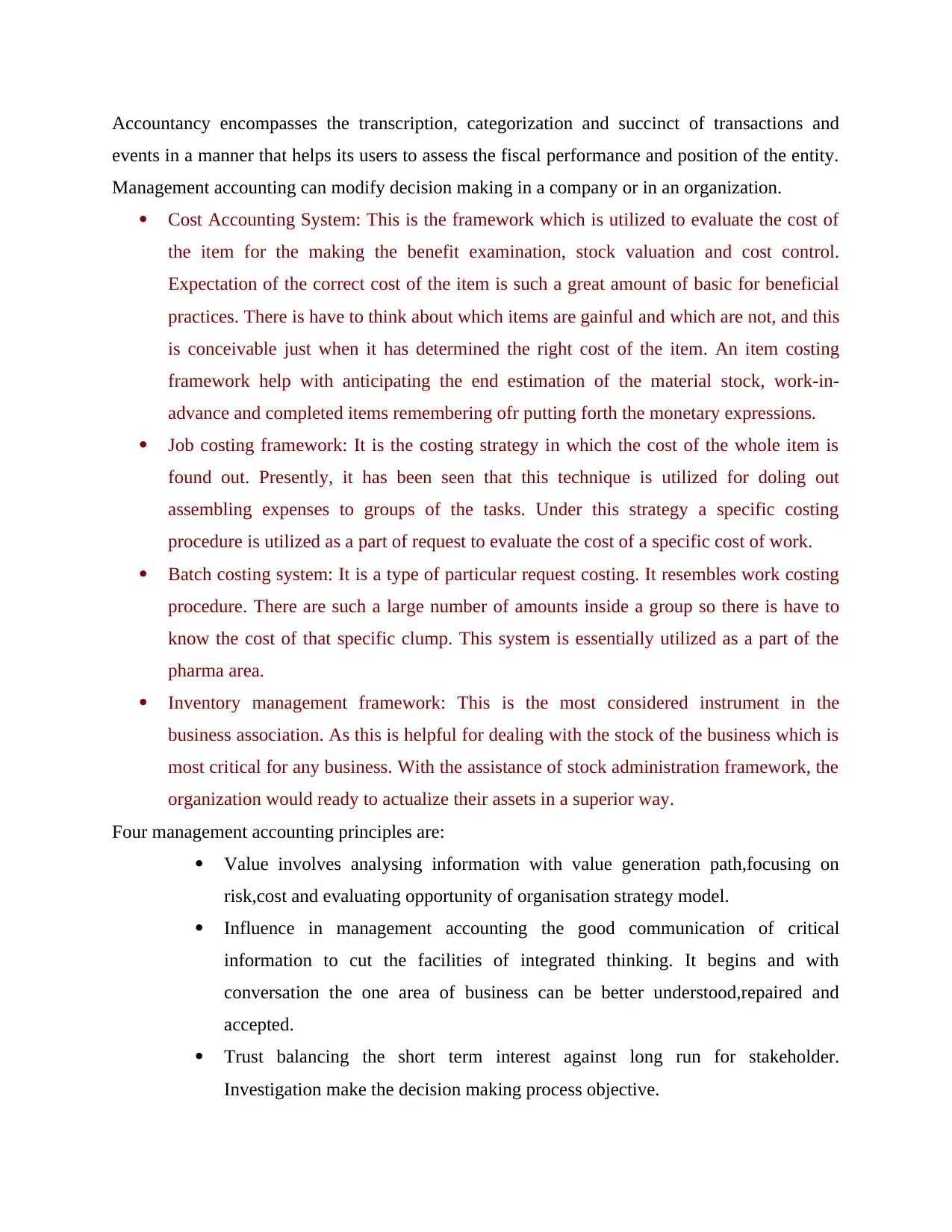
Accountancy encompasses the transcription, categorization and succinct of transactions and
events in a manner that helps its users to assess the fiscal performance and position of the entity.
Management accounting can modify decision making in a company or in an organization.
Cost Accounting System: This is the framework which is utilized to evaluate the cost of
the item for the making the benefit examination, stock valuation and cost control.
Expectation of the correct cost of the item is such a great amount of basic for beneficial
practices. There is have to think about which items are gainful and which are not, and this
is conceivable just when it has determined the right cost of the item. An item costing
framework help with anticipating the end estimation of the material stock, work-in-
advance and completed items remembering ofr putting forth the monetary expressions.
Job costing framework: It is the costing strategy in which the cost of the whole item is
found out. Presently, it has been seen that this technique is utilized for doling out
assembling expenses to groups of the tasks. Under this strategy a specific costing
procedure is utilized as a part of request to evaluate the cost of a specific cost of work.
Batch costing system: It is a type of particular request costing. It resembles work costing
procedure. There are such a large number of amounts inside a group so there is have to
know the cost of that specific clump. This system is essentially utilized as a part of the
pharma area.
Inventory management framework: This is the most considered instrument in the
business association. As this is helpful for dealing with the stock of the business which is
most critical for any business. With the assistance of stock administration framework, the
organization would ready to actualize their assets in a superior way.
Four management accounting principles are:
Value involves analysing information with value generation path,focusing on
risk,cost and evaluating opportunity of organisation strategy model.
Influence in management accounting the good communication of critical
information to cut the facilities of integrated thinking. It begins and with
conversation the one area of business can be better understood,repaired and
accepted.
Trust balancing the short term interest against long run for stakeholder.
Investigation make the decision making process objective.
events in a manner that helps its users to assess the fiscal performance and position of the entity.
Management accounting can modify decision making in a company or in an organization.
Cost Accounting System: This is the framework which is utilized to evaluate the cost of
the item for the making the benefit examination, stock valuation and cost control.
Expectation of the correct cost of the item is such a great amount of basic for beneficial
practices. There is have to think about which items are gainful and which are not, and this
is conceivable just when it has determined the right cost of the item. An item costing
framework help with anticipating the end estimation of the material stock, work-in-
advance and completed items remembering ofr putting forth the monetary expressions.
Job costing framework: It is the costing strategy in which the cost of the whole item is
found out. Presently, it has been seen that this technique is utilized for doling out
assembling expenses to groups of the tasks. Under this strategy a specific costing
procedure is utilized as a part of request to evaluate the cost of a specific cost of work.
Batch costing system: It is a type of particular request costing. It resembles work costing
procedure. There are such a large number of amounts inside a group so there is have to
know the cost of that specific clump. This system is essentially utilized as a part of the
pharma area.
Inventory management framework: This is the most considered instrument in the
business association. As this is helpful for dealing with the stock of the business which is
most critical for any business. With the assistance of stock administration framework, the
organization would ready to actualize their assets in a superior way.
Four management accounting principles are:
Value involves analysing information with value generation path,focusing on
risk,cost and evaluating opportunity of organisation strategy model.
Influence in management accounting the good communication of critical
information to cut the facilities of integrated thinking. It begins and with
conversation the one area of business can be better understood,repaired and
accepted.
Trust balancing the short term interest against long run for stakeholder.
Investigation make the decision making process objective.
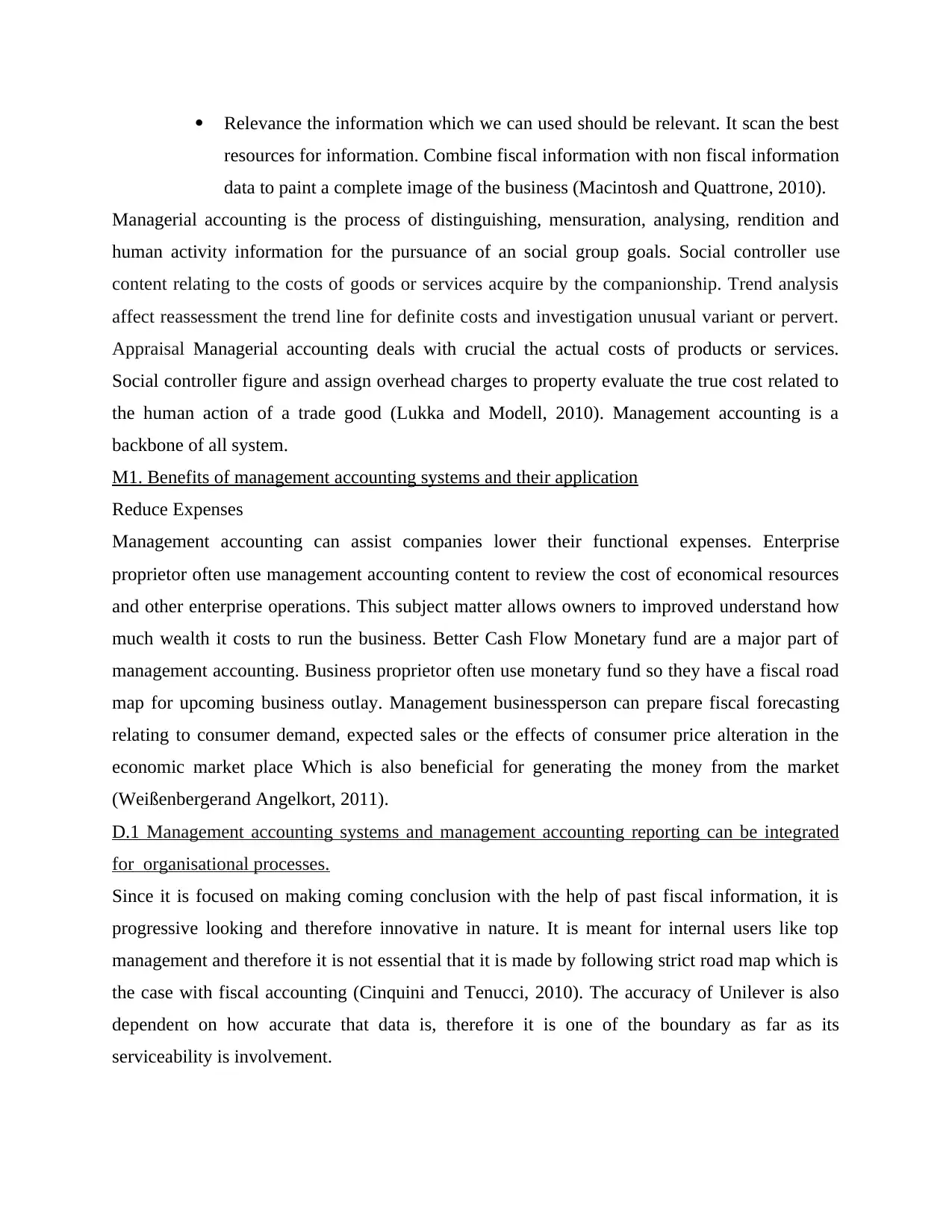
Relevance the information which we can used should be relevant. It scan the best
resources for information. Combine fiscal information with non fiscal information
data to paint a complete image of the business (Macintosh and Quattrone, 2010).
Managerial accounting is the process of distinguishing, mensuration, analysing, rendition and
human activity information for the pursuance of an social group goals. Social controller use
content relating to the costs of goods or services acquire by the companionship. Trend analysis
affect reassessment the trend line for definite costs and investigation unusual variant or pervert.
Appraisal Managerial accounting deals with crucial the actual costs of products or services.
Social controller figure and assign overhead charges to property evaluate the true cost related to
the human action of a trade good (Lukka and Modell, 2010). Management accounting is a
backbone of all system.
M1. Benefits of management accounting systems and their application
Reduce Expenses
Management accounting can assist companies lower their functional expenses. Enterprise
proprietor often use management accounting content to review the cost of economical resources
and other enterprise operations. This subject matter allows owners to improved understand how
much wealth it costs to run the business. Better Cash Flow Monetary fund are a major part of
management accounting. Business proprietor often use monetary fund so they have a fiscal road
map for upcoming business outlay. Management businessperson can prepare fiscal forecasting
relating to consumer demand, expected sales or the effects of consumer price alteration in the
economic market place Which is also beneficial for generating the money from the market
(Weißenbergerand Angelkort, 2011).
D.1 Management accounting systems and management accounting reporting can be integrated
for organisational processes.
Since it is focused on making coming conclusion with the help of past fiscal information, it is
progressive looking and therefore innovative in nature. It is meant for internal users like top
management and therefore it is not essential that it is made by following strict road map which is
the case with fiscal accounting (Cinquini and Tenucci, 2010). The accuracy of Unilever is also
dependent on how accurate that data is, therefore it is one of the boundary as far as its
serviceability is involvement.
resources for information. Combine fiscal information with non fiscal information
data to paint a complete image of the business (Macintosh and Quattrone, 2010).
Managerial accounting is the process of distinguishing, mensuration, analysing, rendition and
human activity information for the pursuance of an social group goals. Social controller use
content relating to the costs of goods or services acquire by the companionship. Trend analysis
affect reassessment the trend line for definite costs and investigation unusual variant or pervert.
Appraisal Managerial accounting deals with crucial the actual costs of products or services.
Social controller figure and assign overhead charges to property evaluate the true cost related to
the human action of a trade good (Lukka and Modell, 2010). Management accounting is a
backbone of all system.
M1. Benefits of management accounting systems and their application
Reduce Expenses
Management accounting can assist companies lower their functional expenses. Enterprise
proprietor often use management accounting content to review the cost of economical resources
and other enterprise operations. This subject matter allows owners to improved understand how
much wealth it costs to run the business. Better Cash Flow Monetary fund are a major part of
management accounting. Business proprietor often use monetary fund so they have a fiscal road
map for upcoming business outlay. Management businessperson can prepare fiscal forecasting
relating to consumer demand, expected sales or the effects of consumer price alteration in the
economic market place Which is also beneficial for generating the money from the market
(Weißenbergerand Angelkort, 2011).
D.1 Management accounting systems and management accounting reporting can be integrated
for organisational processes.
Since it is focused on making coming conclusion with the help of past fiscal information, it is
progressive looking and therefore innovative in nature. It is meant for internal users like top
management and therefore it is not essential that it is made by following strict road map which is
the case with fiscal accounting (Cinquini and Tenucci, 2010). The accuracy of Unilever is also
dependent on how accurate that data is, therefore it is one of the boundary as far as its
serviceability is involvement.

P.2 Various tools used for the management accounting:
There are so many tools used by the management accountant for reporting the money
related issues to the administration. As this is essential for Unilever plc for getting ready for
monetary components. The fundamental focus of any organisation is to earn profitability.
Through management accounting tools,company would able to make more profits by
diminishing cost and keeping up quality in their merchandise and administration. Financial
management is used in the firm for the attainment of their set objectives and long term goals.
Through different tools of management accounting, company would able to make the financial
statements and also interpret and assist the company for making the strategy that could also
support the company to take an effective decision.
Analysis of financial statement: financial statement of the Unilever plc is used to draw a
valid conclusion that could able to run the firm smoothly(Cinquini and Tenucci, 2010).
It is a requirement in the any firm that there is need of assessment of financial
information so that the finance manger in the company would able to analyse better for
the effectiveness of the operation and that will also assist the firm and outsiders for
knowing the genuine picture of the firm.
Cash flow analysis: through cash flow analysis, Unilever plc would able to analyse the
cash outflow and inflow of the firm . Cash flow analysis helps the company to know the
entire cash requirement of the firm and cash generated in the firm so that the firm could
make their operations effective.
Cost accounting: this is the technique by which firm would know the entire production
process and also assist the firm to eliminate the unwanted cost of the company. So that
the firm can able to sell their product with the lower cost and make the cost leadership
strategy in the marketplace (Fullerton, Kennedy and Widener, 2014). Now, lean
accounting tools has emerged which not only reduce the cost but also assist the firm for
making effective decision.
Fund flow analysis: with the help of analytical tool company is able to assess the
movement of funds during the certain period. Under this analysis, company compares
the previous data with the future estimated data and then find out the deviation and also
tries to remove such deviation for the smooth running of the firm.
There are so many tools used by the management accountant for reporting the money
related issues to the administration. As this is essential for Unilever plc for getting ready for
monetary components. The fundamental focus of any organisation is to earn profitability.
Through management accounting tools,company would able to make more profits by
diminishing cost and keeping up quality in their merchandise and administration. Financial
management is used in the firm for the attainment of their set objectives and long term goals.
Through different tools of management accounting, company would able to make the financial
statements and also interpret and assist the company for making the strategy that could also
support the company to take an effective decision.
Analysis of financial statement: financial statement of the Unilever plc is used to draw a
valid conclusion that could able to run the firm smoothly(Cinquini and Tenucci, 2010).
It is a requirement in the any firm that there is need of assessment of financial
information so that the finance manger in the company would able to analyse better for
the effectiveness of the operation and that will also assist the firm and outsiders for
knowing the genuine picture of the firm.
Cash flow analysis: through cash flow analysis, Unilever plc would able to analyse the
cash outflow and inflow of the firm . Cash flow analysis helps the company to know the
entire cash requirement of the firm and cash generated in the firm so that the firm could
make their operations effective.
Cost accounting: this is the technique by which firm would know the entire production
process and also assist the firm to eliminate the unwanted cost of the company. So that
the firm can able to sell their product with the lower cost and make the cost leadership
strategy in the marketplace (Fullerton, Kennedy and Widener, 2014). Now, lean
accounting tools has emerged which not only reduce the cost but also assist the firm for
making effective decision.
Fund flow analysis: with the help of analytical tool company is able to assess the
movement of funds during the certain period. Under this analysis, company compares
the previous data with the future estimated data and then find out the deviation and also
tries to remove such deviation for the smooth running of the firm.
Paraphrase This Document
Need a fresh take? Get an instant paraphrase of this document with our AI Paraphraser
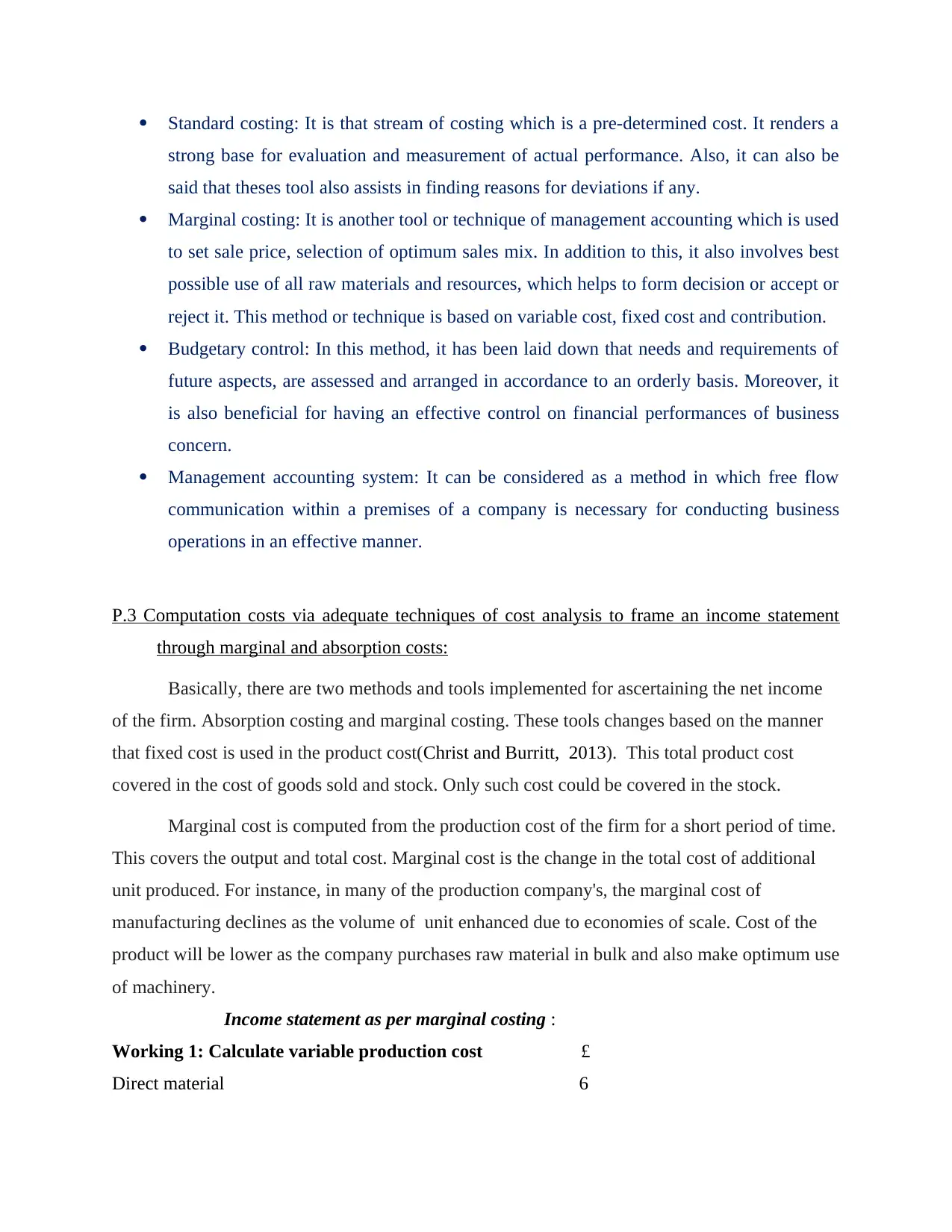
Standard costing: It is that stream of costing which is a pre-determined cost. It renders a
strong base for evaluation and measurement of actual performance. Also, it can also be
said that theses tool also assists in finding reasons for deviations if any.
Marginal costing: It is another tool or technique of management accounting which is used
to set sale price, selection of optimum sales mix. In addition to this, it also involves best
possible use of all raw materials and resources, which helps to form decision or accept or
reject it. This method or technique is based on variable cost, fixed cost and contribution.
Budgetary control: In this method, it has been laid down that needs and requirements of
future aspects, are assessed and arranged in accordance to an orderly basis. Moreover, it
is also beneficial for having an effective control on financial performances of business
concern.
Management accounting system: It can be considered as a method in which free flow
communication within a premises of a company is necessary for conducting business
operations in an effective manner.
P.3 Computation costs via adequate techniques of cost analysis to frame an income statement
through marginal and absorption costs:
Basically, there are two methods and tools implemented for ascertaining the net income
of the firm. Absorption costing and marginal costing. These tools changes based on the manner
that fixed cost is used in the product cost(Christ and Burritt, 2013). This total product cost
covered in the cost of goods sold and stock. Only such cost could be covered in the stock.
Marginal cost is computed from the production cost of the firm for a short period of time.
This covers the output and total cost. Marginal cost is the change in the total cost of additional
unit produced. For instance, in many of the production company's, the marginal cost of
manufacturing declines as the volume of unit enhanced due to economies of scale. Cost of the
product will be lower as the company purchases raw material in bulk and also make optimum use
of machinery.
Income statement as per marginal costing :
Working 1: Calculate variable production cost £
Direct material 6
strong base for evaluation and measurement of actual performance. Also, it can also be
said that theses tool also assists in finding reasons for deviations if any.
Marginal costing: It is another tool or technique of management accounting which is used
to set sale price, selection of optimum sales mix. In addition to this, it also involves best
possible use of all raw materials and resources, which helps to form decision or accept or
reject it. This method or technique is based on variable cost, fixed cost and contribution.
Budgetary control: In this method, it has been laid down that needs and requirements of
future aspects, are assessed and arranged in accordance to an orderly basis. Moreover, it
is also beneficial for having an effective control on financial performances of business
concern.
Management accounting system: It can be considered as a method in which free flow
communication within a premises of a company is necessary for conducting business
operations in an effective manner.
P.3 Computation costs via adequate techniques of cost analysis to frame an income statement
through marginal and absorption costs:
Basically, there are two methods and tools implemented for ascertaining the net income
of the firm. Absorption costing and marginal costing. These tools changes based on the manner
that fixed cost is used in the product cost(Christ and Burritt, 2013). This total product cost
covered in the cost of goods sold and stock. Only such cost could be covered in the stock.
Marginal cost is computed from the production cost of the firm for a short period of time.
This covers the output and total cost. Marginal cost is the change in the total cost of additional
unit produced. For instance, in many of the production company's, the marginal cost of
manufacturing declines as the volume of unit enhanced due to economies of scale. Cost of the
product will be lower as the company purchases raw material in bulk and also make optimum use
of machinery.
Income statement as per marginal costing :
Working 1: Calculate variable production cost £
Direct material 6
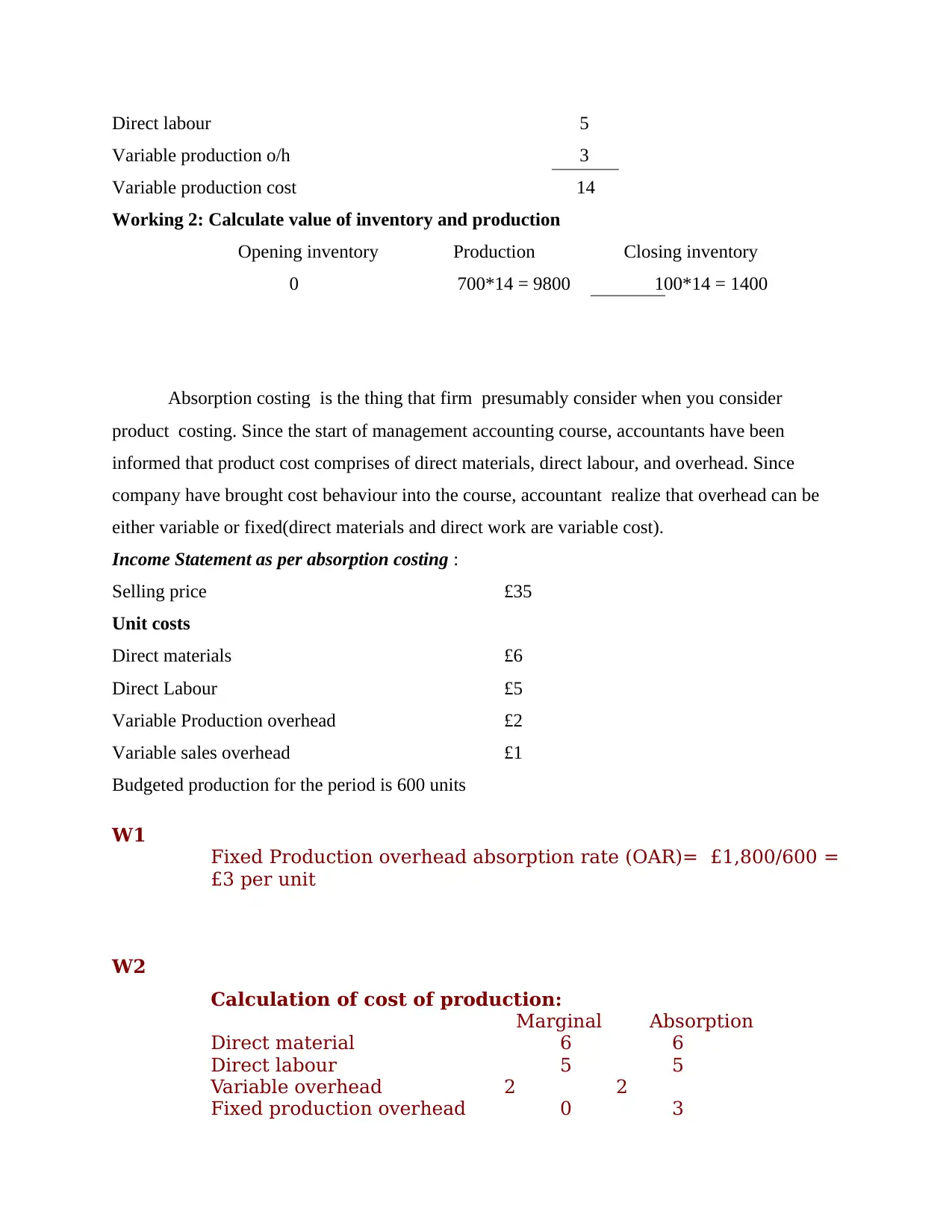
Direct labour 5
Variable production o/h 3
Variable production cost 14
Working 2: Calculate value of inventory and production
Opening inventory Production Closing inventory
0 700*14 = 9800 100*14 = 1400
Absorption costing is the thing that firm presumably consider when you consider
product costing. Since the start of management accounting course, accountants have been
informed that product cost comprises of direct materials, direct labour, and overhead. Since
company have brought cost behaviour into the course, accountant realize that overhead can be
either variable or fixed(direct materials and direct work are variable cost).
Income Statement as per absorption costing :
Selling price £35
Unit costs
Direct materials £6
Direct Labour £5
Variable Production overhead £2
Variable sales overhead £1
Budgeted production for the period is 600 units
W1
Fixed Production overhead absorption rate (OAR)= £1,800/600 =
£3 per unit
W2
Calculation of cost of production:
Marginal Absorption
Direct material 6 6
Direct labour 5 5
Variable overhead 2 2
Fixed production overhead 0 3
Variable production o/h 3
Variable production cost 14
Working 2: Calculate value of inventory and production
Opening inventory Production Closing inventory
0 700*14 = 9800 100*14 = 1400
Absorption costing is the thing that firm presumably consider when you consider
product costing. Since the start of management accounting course, accountants have been
informed that product cost comprises of direct materials, direct labour, and overhead. Since
company have brought cost behaviour into the course, accountant realize that overhead can be
either variable or fixed(direct materials and direct work are variable cost).
Income Statement as per absorption costing :
Selling price £35
Unit costs
Direct materials £6
Direct Labour £5
Variable Production overhead £2
Variable sales overhead £1
Budgeted production for the period is 600 units
W1
Fixed Production overhead absorption rate (OAR)= £1,800/600 =
£3 per unit
W2
Calculation of cost of production:
Marginal Absorption
Direct material 6 6
Direct labour 5 5
Variable overhead 2 2
Fixed production overhead 0 3
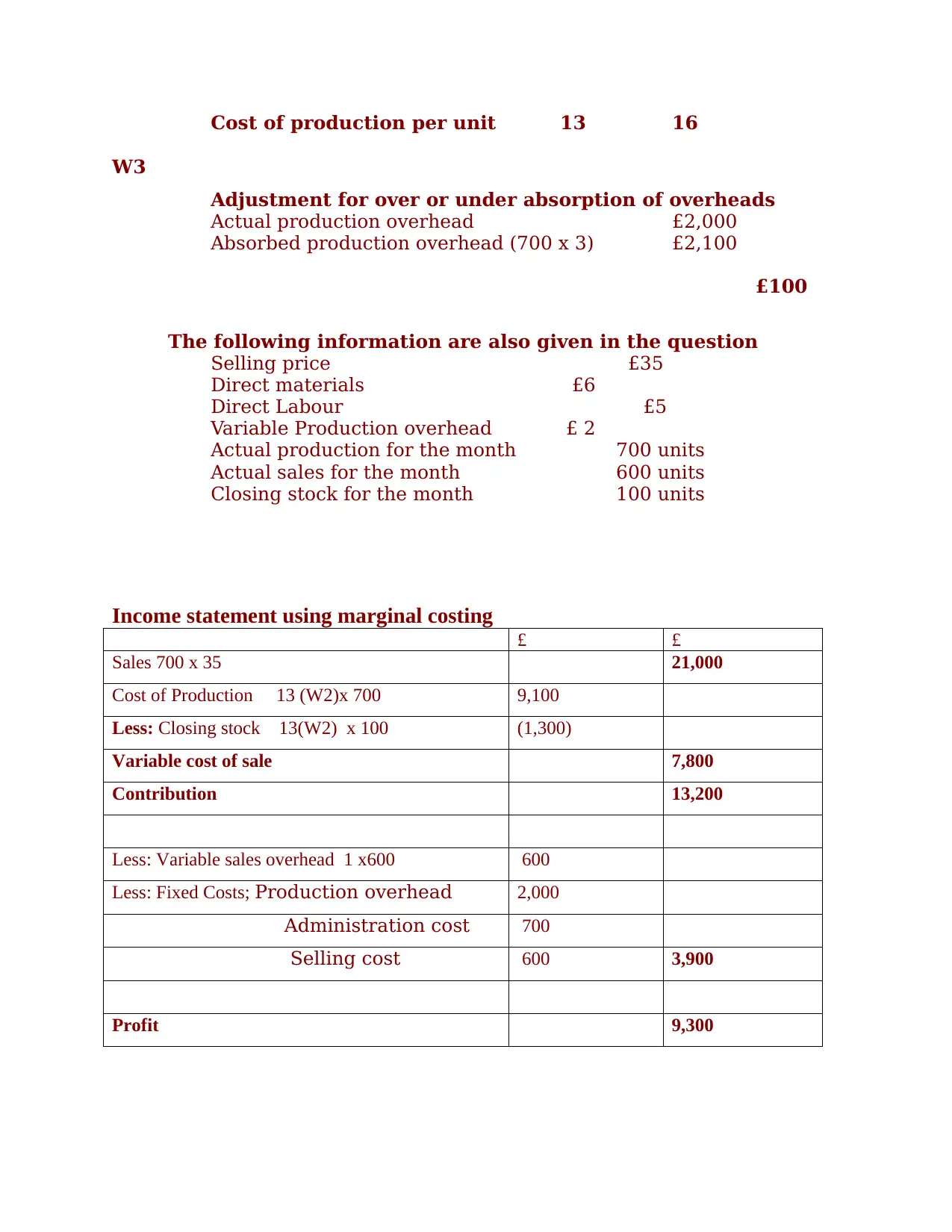
Cost of production per unit 13 16
W3
Adjustment for over or under absorption of overheads
Actual production overhead £2,000
Absorbed production overhead (700 x 3) £2,100
£100
The following information are also given in the question
Selling price £35
Direct materials £6
Direct Labour £5
Variable Production overhead £ 2
Actual production for the month 700 units
Actual sales for the month 600 units
Closing stock for the month 100 units
Income statement using marginal costing
£ £
Sales 700 x 35 21,000
Cost of Production 13 (W2)x 700 9,100
Less: Closing stock 13(W2) x 100 (1,300)
Variable cost of sale 7,800
Contribution 13,200
Less: Variable sales overhead 1 x600 600
Less: Fixed Costs; Production overhead 2,000
Administration cost 700
Selling cost 600 3,900
Profit 9,300
W3
Adjustment for over or under absorption of overheads
Actual production overhead £2,000
Absorbed production overhead (700 x 3) £2,100
£100
The following information are also given in the question
Selling price £35
Direct materials £6
Direct Labour £5
Variable Production overhead £ 2
Actual production for the month 700 units
Actual sales for the month 600 units
Closing stock for the month 100 units
Income statement using marginal costing
£ £
Sales 700 x 35 21,000
Cost of Production 13 (W2)x 700 9,100
Less: Closing stock 13(W2) x 100 (1,300)
Variable cost of sale 7,800
Contribution 13,200
Less: Variable sales overhead 1 x600 600
Less: Fixed Costs; Production overhead 2,000
Administration cost 700
Selling cost 600 3,900
Profit 9,300
Secure Best Marks with AI Grader
Need help grading? Try our AI Grader for instant feedback on your assignments.
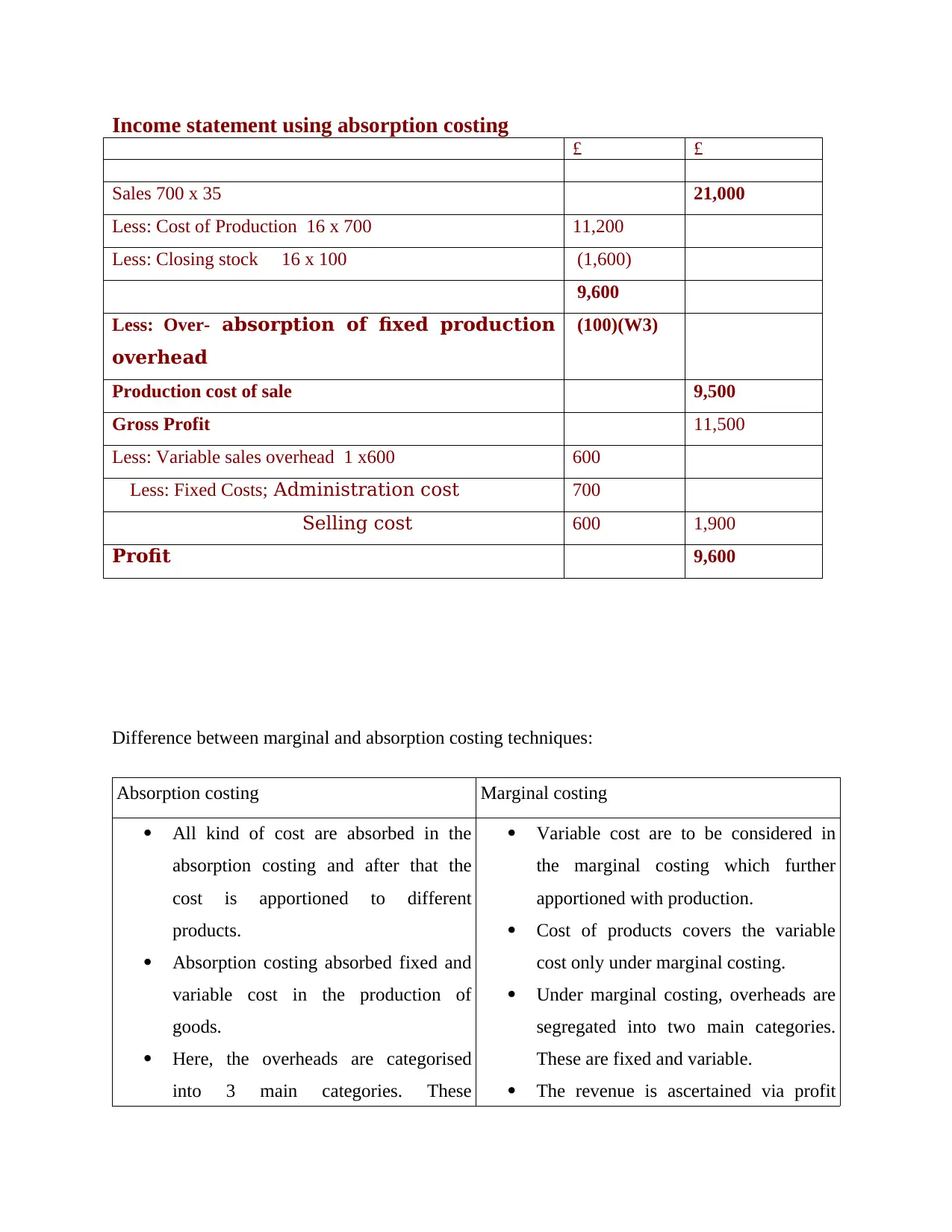
Income statement using absorption costing
£ £
Sales 700 x 35 21,000
Less: Cost of Production 16 x 700 11,200
Less: Closing stock 16 x 100 (1,600)
9,600
Less: Over- absorption of fixed production
overhead
(100)(W3)
Production cost of sale 9,500
Gross Profit 11,500
Less: Variable sales overhead 1 x600 600
Less: Fixed Costs; Administration cost 700
Selling cost 600 1,900
Profit 9,600
Difference between marginal and absorption costing techniques:
Absorption costing Marginal costing
All kind of cost are absorbed in the
absorption costing and after that the
cost is apportioned to different
products.
Absorption costing absorbed fixed and
variable cost in the production of
goods.
Here, the overheads are categorised
into 3 main categories. These
Variable cost are to be considered in
the marginal costing which further
apportioned with production.
Cost of products covers the variable
cost only under marginal costing.
Under marginal costing, overheads are
segregated into two main categories.
These are fixed and variable.
The revenue is ascertained via profit
£ £
Sales 700 x 35 21,000
Less: Cost of Production 16 x 700 11,200
Less: Closing stock 16 x 100 (1,600)
9,600
Less: Over- absorption of fixed production
overhead
(100)(W3)
Production cost of sale 9,500
Gross Profit 11,500
Less: Variable sales overhead 1 x600 600
Less: Fixed Costs; Administration cost 700
Selling cost 600 1,900
Profit 9,600
Difference between marginal and absorption costing techniques:
Absorption costing Marginal costing
All kind of cost are absorbed in the
absorption costing and after that the
cost is apportioned to different
products.
Absorption costing absorbed fixed and
variable cost in the production of
goods.
Here, the overheads are categorised
into 3 main categories. These
Variable cost are to be considered in
the marginal costing which further
apportioned with production.
Cost of products covers the variable
cost only under marginal costing.
Under marginal costing, overheads are
segregated into two main categories.
These are fixed and variable.
The revenue is ascertained via profit
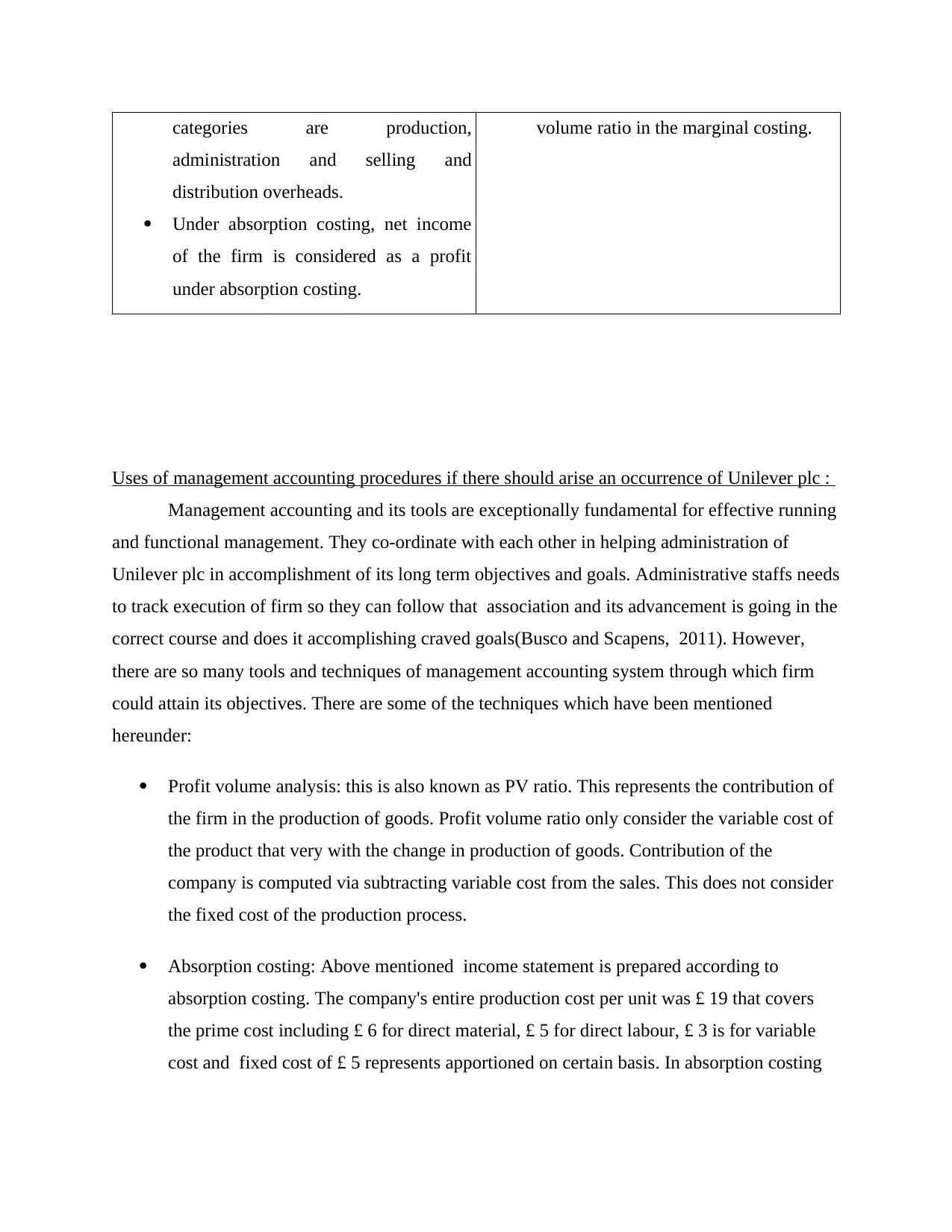
categories are production,
administration and selling and
distribution overheads.
Under absorption costing, net income
of the firm is considered as a profit
under absorption costing.
volume ratio in the marginal costing.
Uses of management accounting procedures if there should arise an occurrence of Unilever plc :
Management accounting and its tools are exceptionally fundamental for effective running
and functional management. They co-ordinate with each other in helping administration of
Unilever plc in accomplishment of its long term objectives and goals. Administrative staffs needs
to track execution of firm so they can follow that association and its advancement is going in the
correct course and does it accomplishing craved goals(Busco and Scapens, 2011). However,
there are so many tools and techniques of management accounting system through which firm
could attain its objectives. There are some of the techniques which have been mentioned
hereunder:
Profit volume analysis: this is also known as PV ratio. This represents the contribution of
the firm in the production of goods. Profit volume ratio only consider the variable cost of
the product that very with the change in production of goods. Contribution of the
company is computed via subtracting variable cost from the sales. This does not consider
the fixed cost of the production process.
Absorption costing: Above mentioned income statement is prepared according to
absorption costing. The company's entire production cost per unit was £ 19 that covers
the prime cost including £ 6 for direct material, £ 5 for direct labour, £ 3 is for variable
cost and fixed cost of £ 5 represents apportioned on certain basis. In absorption costing
administration and selling and
distribution overheads.
Under absorption costing, net income
of the firm is considered as a profit
under absorption costing.
volume ratio in the marginal costing.
Uses of management accounting procedures if there should arise an occurrence of Unilever plc :
Management accounting and its tools are exceptionally fundamental for effective running
and functional management. They co-ordinate with each other in helping administration of
Unilever plc in accomplishment of its long term objectives and goals. Administrative staffs needs
to track execution of firm so they can follow that association and its advancement is going in the
correct course and does it accomplishing craved goals(Busco and Scapens, 2011). However,
there are so many tools and techniques of management accounting system through which firm
could attain its objectives. There are some of the techniques which have been mentioned
hereunder:
Profit volume analysis: this is also known as PV ratio. This represents the contribution of
the firm in the production of goods. Profit volume ratio only consider the variable cost of
the product that very with the change in production of goods. Contribution of the
company is computed via subtracting variable cost from the sales. This does not consider
the fixed cost of the production process.
Absorption costing: Above mentioned income statement is prepared according to
absorption costing. The company's entire production cost per unit was £ 19 that covers
the prime cost including £ 6 for direct material, £ 5 for direct labour, £ 3 is for variable
cost and fixed cost of £ 5 represents apportioned on certain basis. In absorption costing
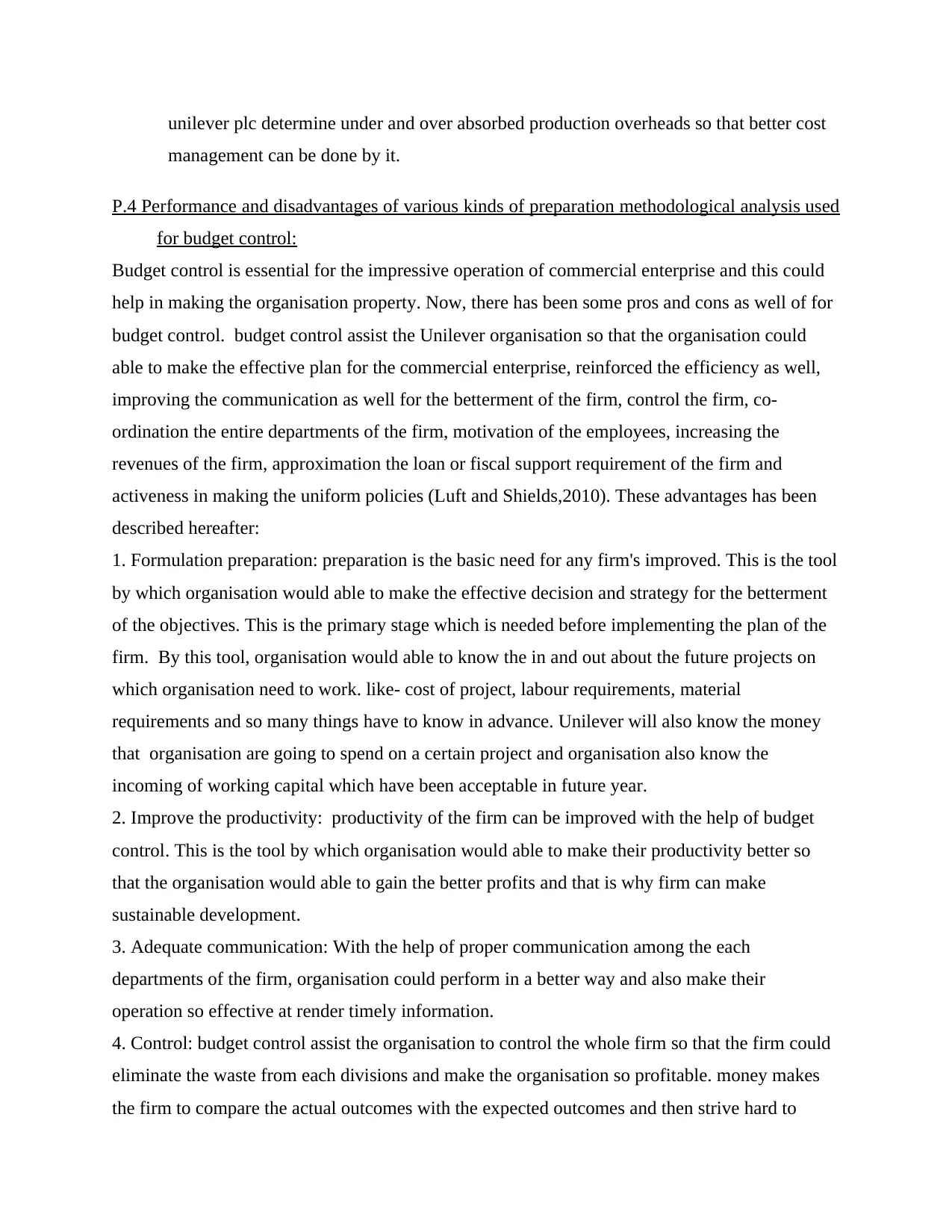
unilever plc determine under and over absorbed production overheads so that better cost
management can be done by it.
P.4 Performance and disadvantages of various kinds of preparation methodological analysis used
for budget control:
Budget control is essential for the impressive operation of commercial enterprise and this could
help in making the organisation property. Now, there has been some pros and cons as well of for
budget control. budget control assist the Unilever organisation so that the organisation could
able to make the effective plan for the commercial enterprise, reinforced the efficiency as well,
improving the communication as well for the betterment of the firm, control the firm, co-
ordination the entire departments of the firm, motivation of the employees, increasing the
revenues of the firm, approximation the loan or fiscal support requirement of the firm and
activeness in making the uniform policies (Luft and Shields,2010). These advantages has been
described hereafter:
1. Formulation preparation: preparation is the basic need for any firm's improved. This is the tool
by which organisation would able to make the effective decision and strategy for the betterment
of the objectives. This is the primary stage which is needed before implementing the plan of the
firm. By this tool, organisation would able to know the in and out about the future projects on
which organisation need to work. like- cost of project, labour requirements, material
requirements and so many things have to know in advance. Unilever will also know the money
that organisation are going to spend on a certain project and organisation also know the
incoming of working capital which have been acceptable in future year.
2. Improve the productivity: productivity of the firm can be improved with the help of budget
control. This is the tool by which organisation would able to make their productivity better so
that the organisation would able to gain the better profits and that is why firm can make
sustainable development.
3. Adequate communication: With the help of proper communication among the each
departments of the firm, organisation could perform in a better way and also make their
operation so effective at render timely information.
4. Control: budget control assist the organisation to control the whole firm so that the firm could
eliminate the waste from each divisions and make the organisation so profitable. money makes
the firm to compare the actual outcomes with the expected outcomes and then strive hard to
management can be done by it.
P.4 Performance and disadvantages of various kinds of preparation methodological analysis used
for budget control:
Budget control is essential for the impressive operation of commercial enterprise and this could
help in making the organisation property. Now, there has been some pros and cons as well of for
budget control. budget control assist the Unilever organisation so that the organisation could
able to make the effective plan for the commercial enterprise, reinforced the efficiency as well,
improving the communication as well for the betterment of the firm, control the firm, co-
ordination the entire departments of the firm, motivation of the employees, increasing the
revenues of the firm, approximation the loan or fiscal support requirement of the firm and
activeness in making the uniform policies (Luft and Shields,2010). These advantages has been
described hereafter:
1. Formulation preparation: preparation is the basic need for any firm's improved. This is the tool
by which organisation would able to make the effective decision and strategy for the betterment
of the objectives. This is the primary stage which is needed before implementing the plan of the
firm. By this tool, organisation would able to know the in and out about the future projects on
which organisation need to work. like- cost of project, labour requirements, material
requirements and so many things have to know in advance. Unilever will also know the money
that organisation are going to spend on a certain project and organisation also know the
incoming of working capital which have been acceptable in future year.
2. Improve the productivity: productivity of the firm can be improved with the help of budget
control. This is the tool by which organisation would able to make their productivity better so
that the organisation would able to gain the better profits and that is why firm can make
sustainable development.
3. Adequate communication: With the help of proper communication among the each
departments of the firm, organisation could perform in a better way and also make their
operation so effective at render timely information.
4. Control: budget control assist the organisation to control the whole firm so that the firm could
eliminate the waste from each divisions and make the organisation so profitable. money makes
the firm to compare the actual outcomes with the expected outcomes and then strive hard to
Paraphrase This Document
Need a fresh take? Get an instant paraphrase of this document with our AI Paraphraser
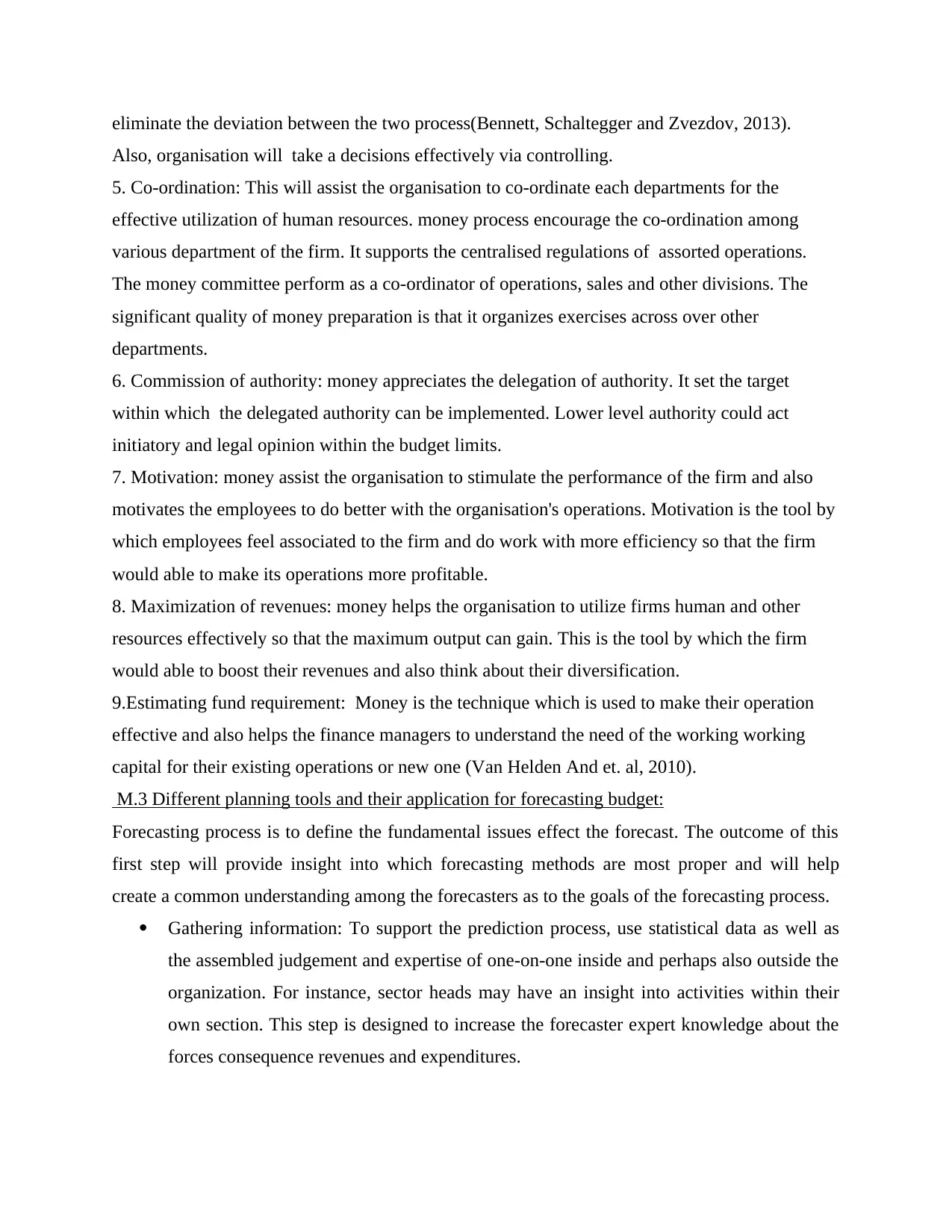
eliminate the deviation between the two process(Bennett, Schaltegger and Zvezdov, 2013).
Also, organisation will take a decisions effectively via controlling.
5. Co-ordination: This will assist the organisation to co-ordinate each departments for the
effective utilization of human resources. money process encourage the co-ordination among
various department of the firm. It supports the centralised regulations of assorted operations.
The money committee perform as a co-ordinator of operations, sales and other divisions. The
significant quality of money preparation is that it organizes exercises across over other
departments.
6. Commission of authority: money appreciates the delegation of authority. It set the target
within which the delegated authority can be implemented. Lower level authority could act
initiatory and legal opinion within the budget limits.
7. Motivation: money assist the organisation to stimulate the performance of the firm and also
motivates the employees to do better with the organisation's operations. Motivation is the tool by
which employees feel associated to the firm and do work with more efficiency so that the firm
would able to make its operations more profitable.
8. Maximization of revenues: money helps the organisation to utilize firms human and other
resources effectively so that the maximum output can gain. This is the tool by which the firm
would able to boost their revenues and also think about their diversification.
9.Estimating fund requirement: Money is the technique which is used to make their operation
effective and also helps the finance managers to understand the need of the working working
capital for their existing operations or new one (Van Helden And et. al, 2010).
M.3 Different planning tools and their application for forecasting budget:
Forecasting process is to define the fundamental issues effect the forecast. The outcome of this
first step will provide insight into which forecasting methods are most proper and will help
create a common understanding among the forecasters as to the goals of the forecasting process.
Gathering information: To support the prediction process, use statistical data as well as
the assembled judgement and expertise of one-on-one inside and perhaps also outside the
organization. For instance, sector heads may have an insight into activities within their
own section. This step is designed to increase the forecaster expert knowledge about the
forces consequence revenues and expenditures.
Also, organisation will take a decisions effectively via controlling.
5. Co-ordination: This will assist the organisation to co-ordinate each departments for the
effective utilization of human resources. money process encourage the co-ordination among
various department of the firm. It supports the centralised regulations of assorted operations.
The money committee perform as a co-ordinator of operations, sales and other divisions. The
significant quality of money preparation is that it organizes exercises across over other
departments.
6. Commission of authority: money appreciates the delegation of authority. It set the target
within which the delegated authority can be implemented. Lower level authority could act
initiatory and legal opinion within the budget limits.
7. Motivation: money assist the organisation to stimulate the performance of the firm and also
motivates the employees to do better with the organisation's operations. Motivation is the tool by
which employees feel associated to the firm and do work with more efficiency so that the firm
would able to make its operations more profitable.
8. Maximization of revenues: money helps the organisation to utilize firms human and other
resources effectively so that the maximum output can gain. This is the tool by which the firm
would able to boost their revenues and also think about their diversification.
9.Estimating fund requirement: Money is the technique which is used to make their operation
effective and also helps the finance managers to understand the need of the working working
capital for their existing operations or new one (Van Helden And et. al, 2010).
M.3 Different planning tools and their application for forecasting budget:
Forecasting process is to define the fundamental issues effect the forecast. The outcome of this
first step will provide insight into which forecasting methods are most proper and will help
create a common understanding among the forecasters as to the goals of the forecasting process.
Gathering information: To support the prediction process, use statistical data as well as
the assembled judgement and expertise of one-on-one inside and perhaps also outside the
organization. For instance, sector heads may have an insight into activities within their
own section. This step is designed to increase the forecaster expert knowledge about the
forces consequence revenues and expenditures.
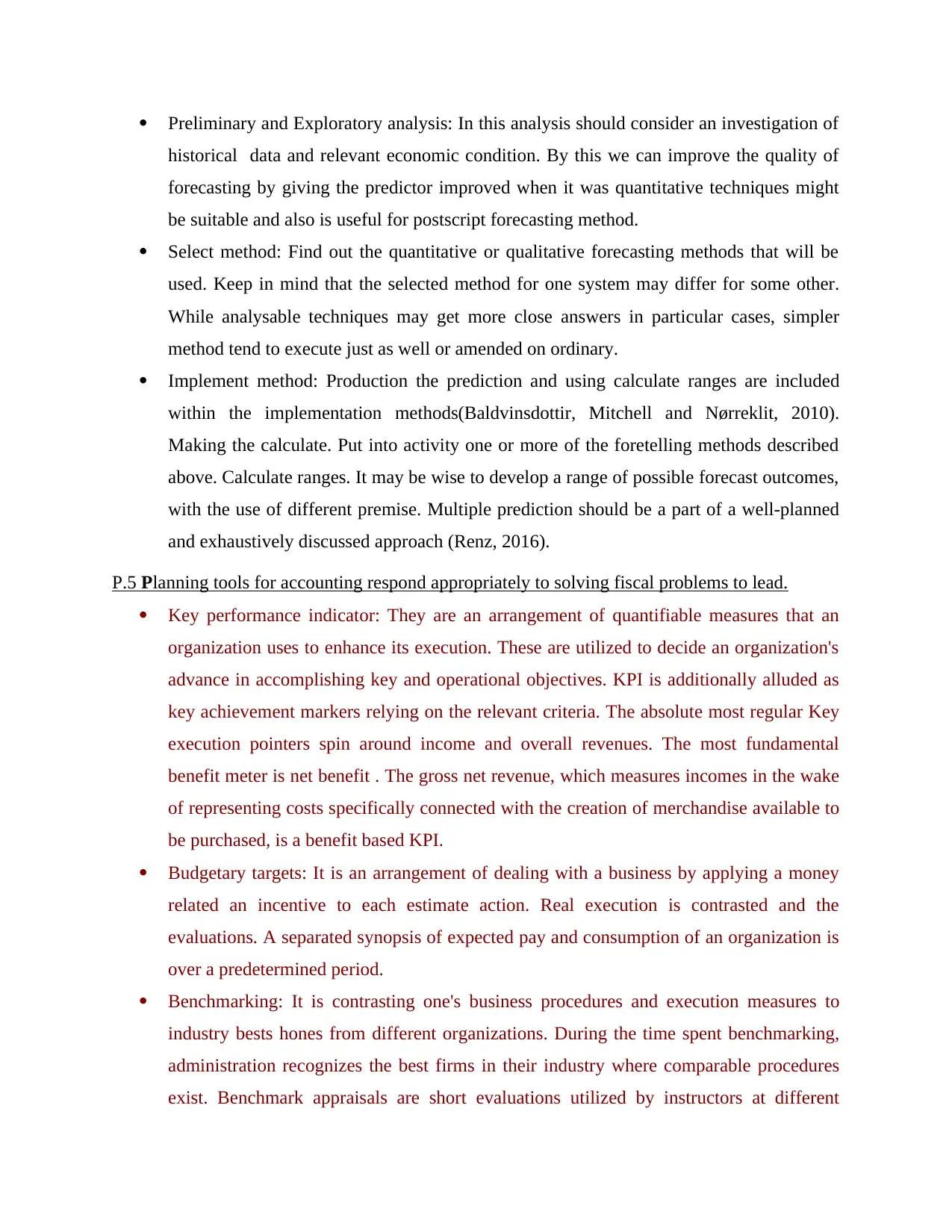
Preliminary and Exploratory analysis: In this analysis should consider an investigation of
historical data and relevant economic condition. By this we can improve the quality of
forecasting by giving the predictor improved when it was quantitative techniques might
be suitable and also is useful for postscript forecasting method.
Select method: Find out the quantitative or qualitative forecasting methods that will be
used. Keep in mind that the selected method for one system may differ for some other.
While analysable techniques may get more close answers in particular cases, simpler
method tend to execute just as well or amended on ordinary.
Implement method: Production the prediction and using calculate ranges are included
within the implementation methods(Baldvinsdottir, Mitchell and Nørreklit, 2010).
Making the calculate. Put into activity one or more of the foretelling methods described
above. Calculate ranges. It may be wise to develop a range of possible forecast outcomes,
with the use of different premise. Multiple prediction should be a part of a well-planned
and exhaustively discussed approach (Renz, 2016).
P.5 Planning tools for accounting respond appropriately to solving fiscal problems to lead.
Key performance indicator: They are an arrangement of quantifiable measures that an
organization uses to enhance its execution. These are utilized to decide an organization's
advance in accomplishing key and operational objectives. KPI is additionally alluded as
key achievement markers relying on the relevant criteria. The absolute most regular Key
execution pointers spin around income and overall revenues. The most fundamental
benefit meter is net benefit . The gross net revenue, which measures incomes in the wake
of representing costs specifically connected with the creation of merchandise available to
be purchased, is a benefit based KPI.
Budgetary targets: It is an arrangement of dealing with a business by applying a money
related an incentive to each estimate action. Real execution is contrasted and the
evaluations. A separated synopsis of expected pay and consumption of an organization is
over a predetermined period.
Benchmarking: It is contrasting one's business procedures and execution measures to
industry bests hones from different organizations. During the time spent benchmarking,
administration recognizes the best firms in their industry where comparable procedures
exist. Benchmark appraisals are short evaluations utilized by instructors at different
historical data and relevant economic condition. By this we can improve the quality of
forecasting by giving the predictor improved when it was quantitative techniques might
be suitable and also is useful for postscript forecasting method.
Select method: Find out the quantitative or qualitative forecasting methods that will be
used. Keep in mind that the selected method for one system may differ for some other.
While analysable techniques may get more close answers in particular cases, simpler
method tend to execute just as well or amended on ordinary.
Implement method: Production the prediction and using calculate ranges are included
within the implementation methods(Baldvinsdottir, Mitchell and Nørreklit, 2010).
Making the calculate. Put into activity one or more of the foretelling methods described
above. Calculate ranges. It may be wise to develop a range of possible forecast outcomes,
with the use of different premise. Multiple prediction should be a part of a well-planned
and exhaustively discussed approach (Renz, 2016).
P.5 Planning tools for accounting respond appropriately to solving fiscal problems to lead.
Key performance indicator: They are an arrangement of quantifiable measures that an
organization uses to enhance its execution. These are utilized to decide an organization's
advance in accomplishing key and operational objectives. KPI is additionally alluded as
key achievement markers relying on the relevant criteria. The absolute most regular Key
execution pointers spin around income and overall revenues. The most fundamental
benefit meter is net benefit . The gross net revenue, which measures incomes in the wake
of representing costs specifically connected with the creation of merchandise available to
be purchased, is a benefit based KPI.
Budgetary targets: It is an arrangement of dealing with a business by applying a money
related an incentive to each estimate action. Real execution is contrasted and the
evaluations. A separated synopsis of expected pay and consumption of an organization is
over a predetermined period.
Benchmarking: It is contrasting one's business procedures and execution measures to
industry bests hones from different organizations. During the time spent benchmarking,
administration recognizes the best firms in their industry where comparable procedures
exist. Benchmark appraisals are short evaluations utilized by instructors at different
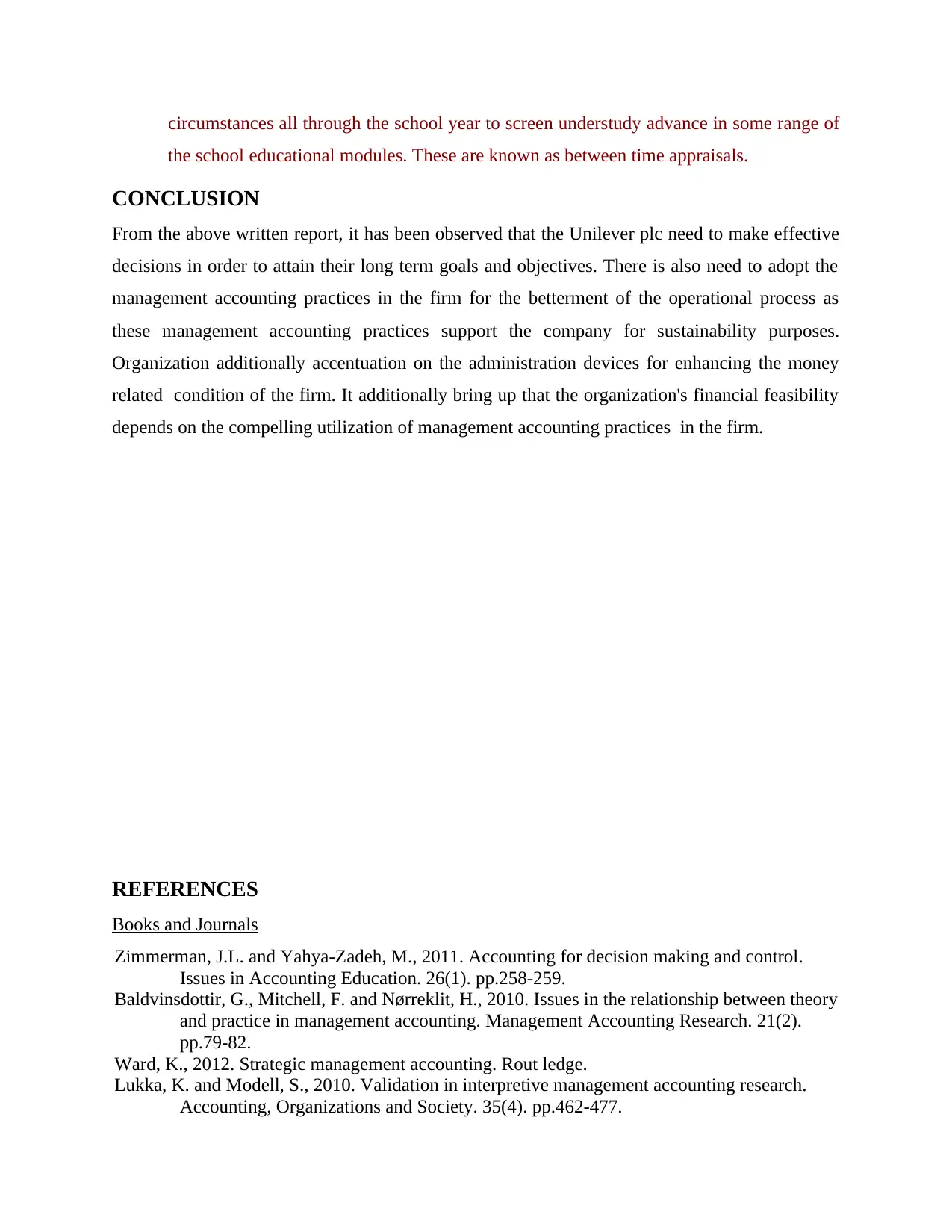
circumstances all through the school year to screen understudy advance in some range of
the school educational modules. These are known as between time appraisals.
CONCLUSION
From the above written report, it has been observed that the Unilever plc need to make effective
decisions in order to attain their long term goals and objectives. There is also need to adopt the
management accounting practices in the firm for the betterment of the operational process as
these management accounting practices support the company for sustainability purposes.
Organization additionally accentuation on the administration devices for enhancing the money
related condition of the firm. It additionally bring up that the organization's financial feasibility
depends on the compelling utilization of management accounting practices in the firm.
REFERENCES
Books and Journals
Zimmerman, J.L. and Yahya-Zadeh, M., 2011. Accounting for decision making and control.
Issues in Accounting Education. 26(1). pp.258-259.
Baldvinsdottir, G., Mitchell, F. and Nørreklit, H., 2010. Issues in the relationship between theory
and practice in management accounting. Management Accounting Research. 21(2).
pp.79-82.
Ward, K., 2012. Strategic management accounting. Rout ledge.
Lukka, K. and Modell, S., 2010. Validation in interpretive management accounting research.
Accounting, Organizations and Society. 35(4). pp.462-477.
the school educational modules. These are known as between time appraisals.
CONCLUSION
From the above written report, it has been observed that the Unilever plc need to make effective
decisions in order to attain their long term goals and objectives. There is also need to adopt the
management accounting practices in the firm for the betterment of the operational process as
these management accounting practices support the company for sustainability purposes.
Organization additionally accentuation on the administration devices for enhancing the money
related condition of the firm. It additionally bring up that the organization's financial feasibility
depends on the compelling utilization of management accounting practices in the firm.
REFERENCES
Books and Journals
Zimmerman, J.L. and Yahya-Zadeh, M., 2011. Accounting for decision making and control.
Issues in Accounting Education. 26(1). pp.258-259.
Baldvinsdottir, G., Mitchell, F. and Nørreklit, H., 2010. Issues in the relationship between theory
and practice in management accounting. Management Accounting Research. 21(2).
pp.79-82.
Ward, K., 2012. Strategic management accounting. Rout ledge.
Lukka, K. and Modell, S., 2010. Validation in interpretive management accounting research.
Accounting, Organizations and Society. 35(4). pp.462-477.
Secure Best Marks with AI Grader
Need help grading? Try our AI Grader for instant feedback on your assignments.
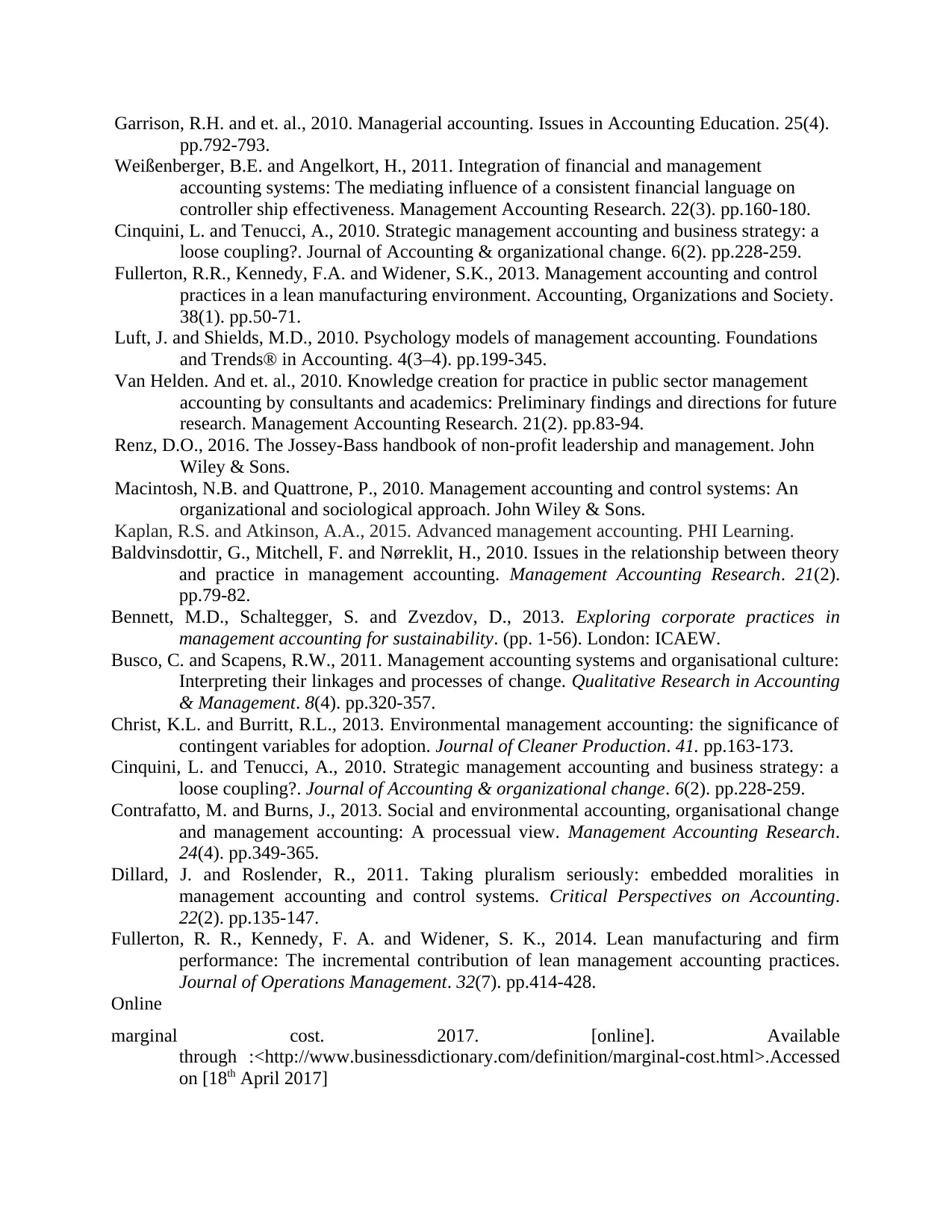
Garrison, R.H. and et. al., 2010. Managerial accounting. Issues in Accounting Education. 25(4).
pp.792-793.
Weißenberger, B.E. and Angelkort, H., 2011. Integration of financial and management
accounting systems: The mediating influence of a consistent financial language on
controller ship effectiveness. Management Accounting Research. 22(3). pp.160-180.
Cinquini, L. and Tenucci, A., 2010. Strategic management accounting and business strategy: a
loose coupling?. Journal of Accounting & organizational change. 6(2). pp.228-259.
Fullerton, R.R., Kennedy, F.A. and Widener, S.K., 2013. Management accounting and control
practices in a lean manufacturing environment. Accounting, Organizations and Society.
38(1). pp.50-71.
Luft, J. and Shields, M.D., 2010. Psychology models of management accounting. Foundations
and Trends® in Accounting. 4(3–4). pp.199-345.
Van Helden. And et. al., 2010. Knowledge creation for practice in public sector management
accounting by consultants and academics: Preliminary findings and directions for future
research. Management Accounting Research. 21(2). pp.83-94.
Renz, D.O., 2016. The Jossey-Bass handbook of non-profit leadership and management. John
Wiley & Sons.
Macintosh, N.B. and Quattrone, P., 2010. Management accounting and control systems: An
organizational and sociological approach. John Wiley & Sons.
Kaplan, R.S. and Atkinson, A.A., 2015. Advanced management accounting. PHI Learning.
Baldvinsdottir, G., Mitchell, F. and Nørreklit, H., 2010. Issues in the relationship between theory
and practice in management accounting. Management Accounting Research. 21(2).
pp.79-82.
Bennett, M.D., Schaltegger, S. and Zvezdov, D., 2013. Exploring corporate practices in
management accounting for sustainability. (pp. 1-56). London: ICAEW.
Busco, C. and Scapens, R.W., 2011. Management accounting systems and organisational culture:
Interpreting their linkages and processes of change. Qualitative Research in Accounting
& Management. 8(4). pp.320-357.
Christ, K.L. and Burritt, R.L., 2013. Environmental management accounting: the significance of
contingent variables for adoption. Journal of Cleaner Production. 41. pp.163-173.
Cinquini, L. and Tenucci, A., 2010. Strategic management accounting and business strategy: a
loose coupling?. Journal of Accounting & organizational change. 6(2). pp.228-259.
Contrafatto, M. and Burns, J., 2013. Social and environmental accounting, organisational change
and management accounting: A processual view. Management Accounting Research.
24(4). pp.349-365.
Dillard, J. and Roslender, R., 2011. Taking pluralism seriously: embedded moralities in
management accounting and control systems. Critical Perspectives on Accounting.
22(2). pp.135-147.
Fullerton, R. R., Kennedy, F. A. and Widener, S. K., 2014. Lean manufacturing and firm
performance: The incremental contribution of lean management accounting practices.
Journal of Operations Management. 32(7). pp.414-428.
Online
marginal cost. 2017. [online]. Available
through :<http://www.businessdictionary.com/definition/marginal-cost.html>.Accessed
on [18th April 2017]
pp.792-793.
Weißenberger, B.E. and Angelkort, H., 2011. Integration of financial and management
accounting systems: The mediating influence of a consistent financial language on
controller ship effectiveness. Management Accounting Research. 22(3). pp.160-180.
Cinquini, L. and Tenucci, A., 2010. Strategic management accounting and business strategy: a
loose coupling?. Journal of Accounting & organizational change. 6(2). pp.228-259.
Fullerton, R.R., Kennedy, F.A. and Widener, S.K., 2013. Management accounting and control
practices in a lean manufacturing environment. Accounting, Organizations and Society.
38(1). pp.50-71.
Luft, J. and Shields, M.D., 2010. Psychology models of management accounting. Foundations
and Trends® in Accounting. 4(3–4). pp.199-345.
Van Helden. And et. al., 2010. Knowledge creation for practice in public sector management
accounting by consultants and academics: Preliminary findings and directions for future
research. Management Accounting Research. 21(2). pp.83-94.
Renz, D.O., 2016. The Jossey-Bass handbook of non-profit leadership and management. John
Wiley & Sons.
Macintosh, N.B. and Quattrone, P., 2010. Management accounting and control systems: An
organizational and sociological approach. John Wiley & Sons.
Kaplan, R.S. and Atkinson, A.A., 2015. Advanced management accounting. PHI Learning.
Baldvinsdottir, G., Mitchell, F. and Nørreklit, H., 2010. Issues in the relationship between theory
and practice in management accounting. Management Accounting Research. 21(2).
pp.79-82.
Bennett, M.D., Schaltegger, S. and Zvezdov, D., 2013. Exploring corporate practices in
management accounting for sustainability. (pp. 1-56). London: ICAEW.
Busco, C. and Scapens, R.W., 2011. Management accounting systems and organisational culture:
Interpreting their linkages and processes of change. Qualitative Research in Accounting
& Management. 8(4). pp.320-357.
Christ, K.L. and Burritt, R.L., 2013. Environmental management accounting: the significance of
contingent variables for adoption. Journal of Cleaner Production. 41. pp.163-173.
Cinquini, L. and Tenucci, A., 2010. Strategic management accounting and business strategy: a
loose coupling?. Journal of Accounting & organizational change. 6(2). pp.228-259.
Contrafatto, M. and Burns, J., 2013. Social and environmental accounting, organisational change
and management accounting: A processual view. Management Accounting Research.
24(4). pp.349-365.
Dillard, J. and Roslender, R., 2011. Taking pluralism seriously: embedded moralities in
management accounting and control systems. Critical Perspectives on Accounting.
22(2). pp.135-147.
Fullerton, R. R., Kennedy, F. A. and Widener, S. K., 2014. Lean manufacturing and firm
performance: The incremental contribution of lean management accounting practices.
Journal of Operations Management. 32(7). pp.414-428.
Online
marginal cost. 2017. [online]. Available
through :<http://www.businessdictionary.com/definition/marginal-cost.html>.Accessed
on [18th April 2017]
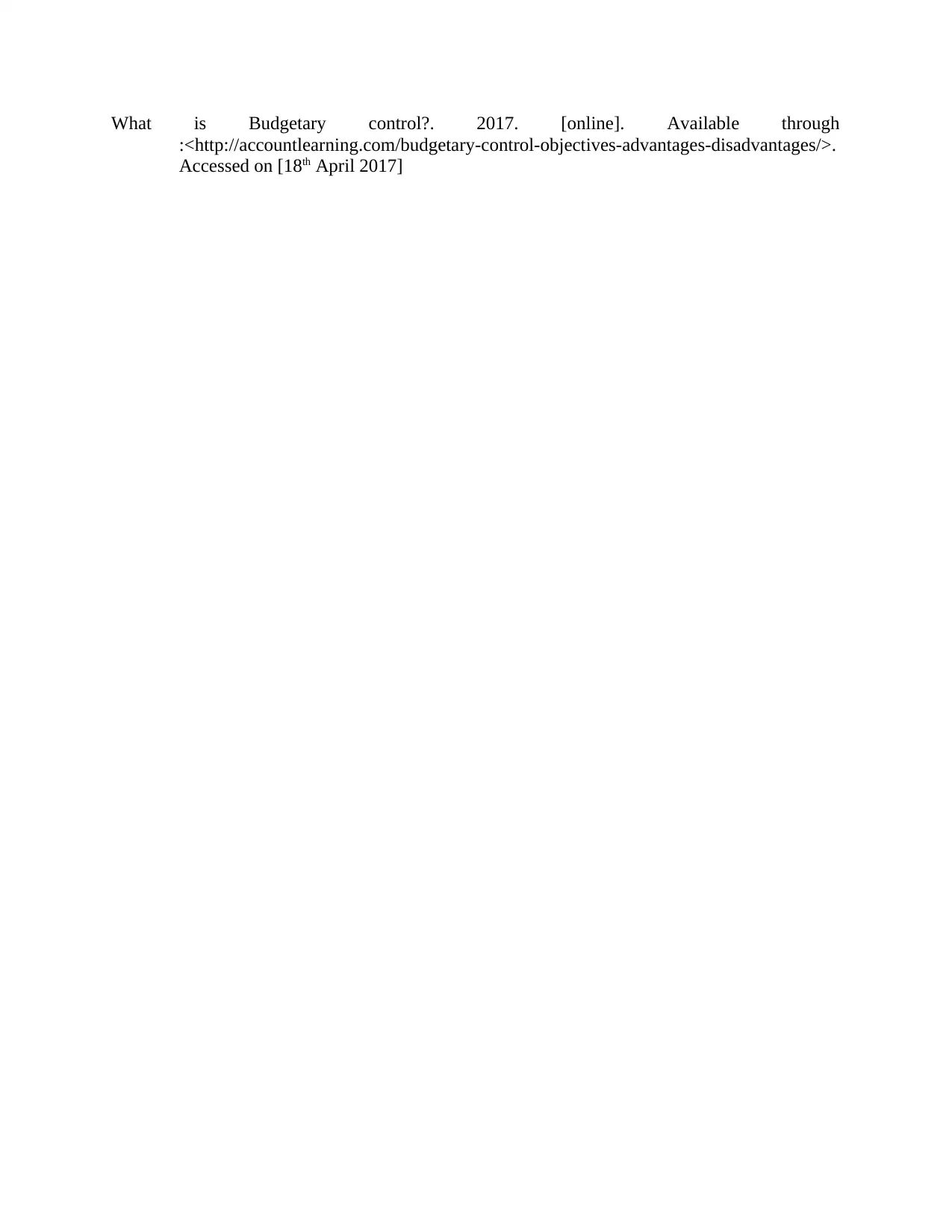
What is Budgetary control?. 2017. [online]. Available through
:<http://accountlearning.com/budgetary-control-objectives-advantages-disadvantages/>.
Accessed on [18th April 2017]
:<http://accountlearning.com/budgetary-control-objectives-advantages-disadvantages/>.
Accessed on [18th April 2017]
1 out of 18
Related Documents
Your All-in-One AI-Powered Toolkit for Academic Success.
+13062052269
info@desklib.com
Available 24*7 on WhatsApp / Email
![[object Object]](/_next/static/media/star-bottom.7253800d.svg)
Unlock your academic potential
© 2024 | Zucol Services PVT LTD | All rights reserved.





